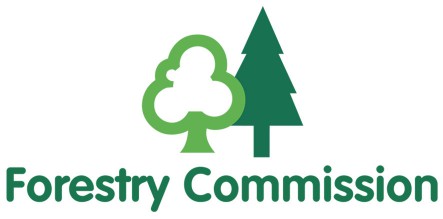The Urban FWAC Network vision
Published 1 July 2025
Applies to England
The Urban Forestry and Woodland Advisory Committee Network (Urban FWAC Network) was established by the Forestry Commission in 2014 to act as the Forestry Commission’s trusted urban forestry stakeholder group, to promote urban forestry in England’s towns and cities and spread good practice around urban forestry.
Foreword by Sir William Worsley
It is my pleasure to write the foreword to the Urban Forestry and Woodland Advisory Network’s refreshed vision for urban forestry. This is intended to be the Network’s complementary take on urban forestry, complementing the Forestry Commission’s 2023 to 2028 Thriving for the Future strategy. The refreshed vision aims to echo that and offer some concrete outcomes for how we can measure the success of this regarding the urban forest.
It is of course very appropriate for the Urban FWAC Network to produce this refreshed vision as the majority of the population of England live in urban areas. Therefore, the planting and management of trees and woodlands in our towns and cities will be absolutely key to help fulfil government ambitions in relation to the multiple benefits trees and woodlands can provide.
To echo my introduction to Thriving for the Future, put simply, we need more and better managed trees in our urban areas to meet our ambitions for nature and society and this Vision refresh will surely help focus attention on how we can achieve this.
Sir William Worsley, Chair of the Forestry Commission.

Urban trees outside an office building. Crown copyright.
Introduction by Urban FWAC Network Chair Andrew Jones
The Urban FWAC Network has refreshed and updated the ‘Vision for a Resilient Urban Forest’ first published in 2015. The benefits of trees in our town and cities are more widely recognised than ever and many of the ambitions set out in the first vision are being realised.
However, securing a sustainable future for the urban forest will require a collective effort as the urban forest still faces many challenges. This vision provides an important guide for all of us who care for the urban forest. It outlines the actions the network believes need to be taken to ensure the urban forest continues to be sustained and enhanced, building on the activity that has taken place since the original vision was published
The network was established by the Forestry Commission to act as the Forestry Commission’s trusted urban forestry stakeholder group, to promote urban forestry in England’s towns and cities and spread good practice around urban forestry. Every FWAC nominates a representative to the network and additional experts in urban forestry sit on the network by invitation. All current members are committed to securing a future for the urban forest and I am delighted that Sir William, Forestry Commission Chair, a strong supporter of urban forestry, has endorsed the vision.
Since the 2015 vision was published more is now known about the scale and value of the urban forest. New tools such as i-Tree Eco are helping value the urban forest whilst tree equity mapping is helping local communities, businesses and local authorities identify where tree planting could benefit those living in town and cities. More town and cities have also set targets to increase tree and canopy cover.
Everybody who is involved in the management of trees and woodland in our towns and cities should consider the implications of the issues and actions and set out how these will be addressed. This could be through a green infrastructure strategy, local nature recovery plan or tree and woodland strategy.
Those with a stake in managing the urban forest includes the owners of land with trees – local authorities, utility companies, community groups and individual residents, professionals who work with trees, and all of us who live, work in and will benefit from the resilient urban forest. The network of FWACs will work to enable and encourage England’s urban areas to make a commitment to address the current challenges associated with the climate and biodiversity crises we currently face and spread the benefits the urban forest provides.
Andrew Jones, Chair of the Urban FWAC Network.
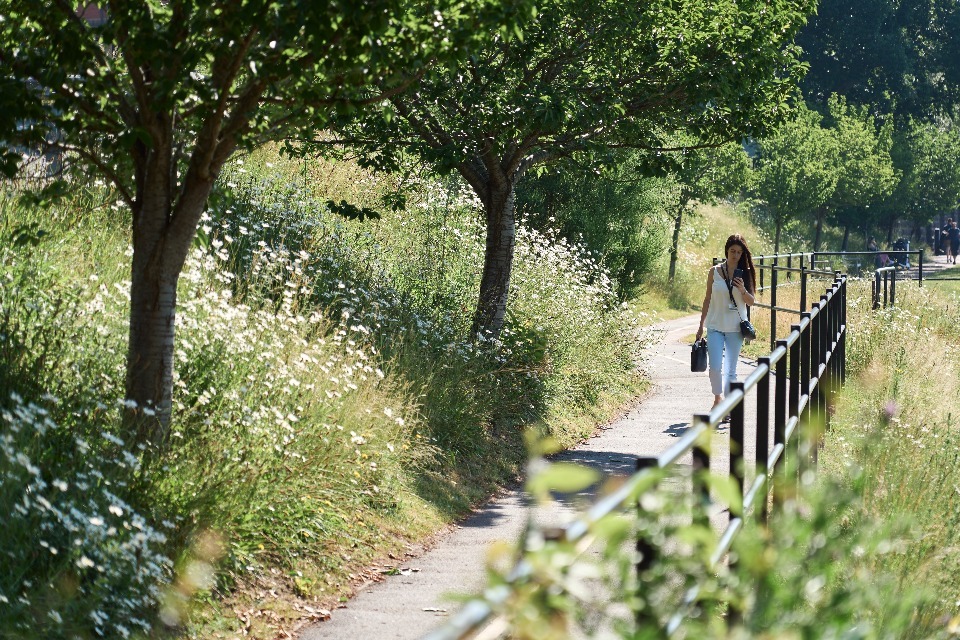
Urban trees in Birmingham as part of the Birmingham Urban Forest Master Plan. Copyright: University of Birmingham.
The Urban FWAC Network’s vision for the urban forest
This vision channels the ambitions for trees and woodlands outlined in the Forestry Commission’s current strategy Thriving for the Future (2023-2028) and applies them to the urban forest, that is all the trees in the urban realm. To that end, Thriving for the Future sets outs 3 goals for trees and woodlands:
- Goal 1: more trees, more diverse species, growing and thriving
- Goal 2: better managed woods and forests that are protected and improving
- Goal 3: bigger benefits for nature, climate, people and the economy
This vision therefore seeks to look at how each of these goals could be implemented in the urban context so the urban forest can play its part in achieving all that society needs from trees and woodlands. For each of the goals, we set out some context, the network’s main ambitions and some useful case studies that demonstrate some of the positive and innovative work going on in managing the urban forest.
Goal 1: more trees, more diverse species, growing and thriving
The government is committed under the Environment Act to increase tree canopy cover to 16.5% in England by 2050. We applaud this and also encourage the setting of locally appropriate and ambitious canopy cover targets by tree managers in urban areas alongside this national target.
We also believe that the emerging work on tree equity should be factored into the implementation of government tree planting targets. This will enable areas with less canopy cover to be prioritised for increasing canopy cover.
We propose that the management and growth of the urban forest should continue to be well supported by a mix of public and private finance and that any grant support should take the long-term view needed to support our urban trees and woodlands.
We see biodiversity net gain (BNG) playing an important role in providing some of that private finance needed to ensure our urban forests grow and are managed to deliver a wide range of benefits. We believe that our changing climate should be considered when selecting species and that an evidence-based approach to species selection must be adopted to ensure our urban forests survive and thrive.
Main ambitions for the urban forest under goal 1
Tree equity – any public or private support for tree planting in urban areas should aim to target those areas with smaller existing canopy cover as a priority.
Funding – the future of the urban forest is reliant on ongoing public investment as many urban trees, such as street trees, exist within the public realm. Any future public funding for the growth and management of the urban forest should focus on providing a longer-term funding package to help tree managers take a longer-term approach.
BNG – the adoption of BNG to mitigate against development impacts should see the urban forest grow and thrive.
Species selection – tree managers should take an evidence-based approach to species selection, considering future climate projections to ensure that trees planted in the urban forest are able to thrive into the future.
Design and maintenance – urban trees should be planted and maintained with the best current practice in mind, using for example the guidance produced and published by the Trees and Design Action Group.
Case studies
Camden Tree Planting
Camden’s tree planting strategy 2020-2025 sets out a holistic approach to tree planting that is evidence led and covers more than planting trees. It sets out a canopy cover goal for 2045 and how this will be achieved, with reference made to increasing species diversity, maximising the benefits of trees, biosecurity, improving aftercare and monitoring.
This is not possible for the local authority to achieve alone, and they are working with community groups to achieve this.
The London Urban Forest Plan
The London Urban Forest Plan sets out the goals and priority actions to protect, manage and expand London’s urban forest, so that trees can play their role in ensuring a greener and fairer London in a time of climate and nature crisis. It was published in 2020 by the London Urban Forest Partnership, which enables a city-wide network of organisations that collaborate to protect, manage and enhance London’s trees and woodlands.
The plan forms part of a package of green infrastructure policy frameworks within Greater London including the London Local Nature Recovery Strategy. So far, existence of the plan has helped the partnership secure ‘Trees Call to Action’ funding, enabling the delivery of a range of actions including the preparation of a London Deer Strategy, woodland creation opportunity mapping, systematic rebuilding of the Ancient Woodland Inventory dataset for Greater London as well as other projects assessing skills gaps and connecting communities to woodland creation and street tree planting.
The action plan has now been refreshed for the next 5 years, underpinned by the principles of equity and inclusion, resilience, collaboration and capacity.
All Our Trees
All Our Trees is Greater Manchester’s Tree and Woodland Strategy. The Greater Manchester Combined Authority was quick to adopt the natural capital approach to environmental management. City of Trees, as the community forest for Greater Manchester wanted to be able to respond to the question: ‘Where will we get most benefit for investment in trees?’ and to prepare a spatial plan for tree planting which could sit alongside and be referenced by the Greater Manchester Combined Authority’s other emerging strategic plans.
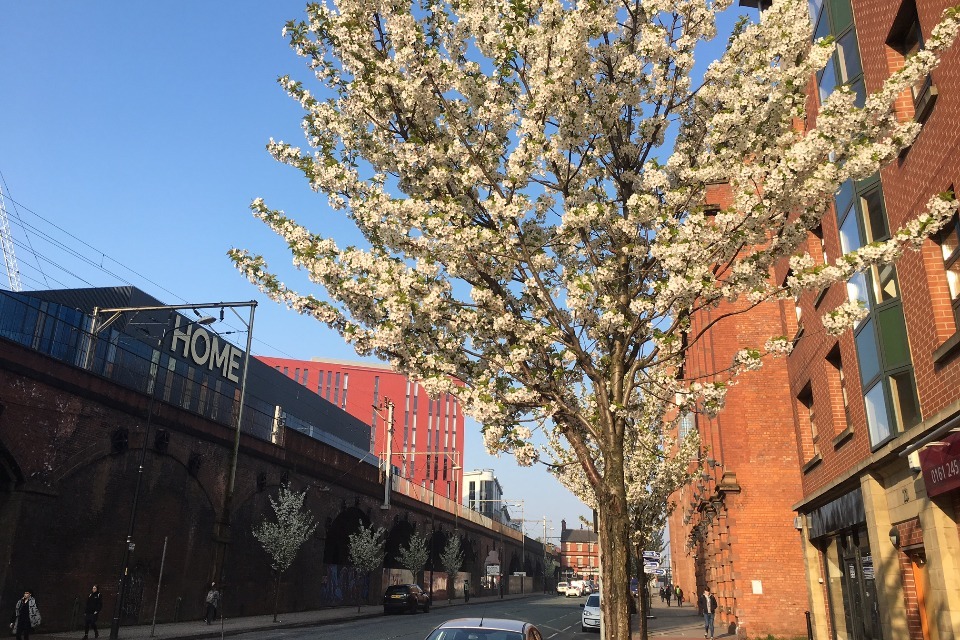
An urban tree in blossom as part of the All Our Trees project. Copyright: City of Trees.
To understand what Greater Manchester already had in terms of tree canopy, and what it was delivering in terms of ecosystem services, City of Trees undertook the largest sample-based survey of tree form and function (i-Tree Eco) outside the USA.
City of Trees also used high resolution mapping to identify all available land suitable for tree planting and overlaid this with spatial datasets to evidence the suite of ecosystem benefits that trees can provide to produce a high-resolution composite priority map for tree planting in Greater Manchester.
Goal 2: better managed woods and forests that are protected and improving
The government is committed to more and better management of trees and woodlands in England, and this includes urban trees and woodlands. We wish to see the urban forest becoming better protected and loved, and its importance recognised by national and local decision makers in helping to achieve government and society’s environmental, cultural and economic ambitions. Our ambition is that the urban forest will not just grow but will be managed to a higher quality standard.
We wish to see knowledge about the urban forest better disseminated through the sector and more standardised training and career development pathways developed. We call on all layers of government to ensure that focus is given to tree establishment and management and not just meeting planting targets, and that management will be to a high quality.
We would like to see utility companies, builders and developers being better informed around policy and good practice around the urban forest and the implementation of this done in a more standardised way.
Main ambitions for the urban forest under goal 2
Sustainable management - more of the urban forest will be managed sustainably. The majority of local authorities in England will have a Trees and Woodland Strategy or relevant urban tree policies in place and management will be carried out to a high standard across the country.
Pests and diseases – urban forest managers will have plans in place to deal with new and emerging pests and diseases.
Local authority staffing – there will be an employed tree specialist in every local authority that has tree management responsibilities. Local authorities will work collaboratively (e.g. tree managers, planners and highway engineers) to better manage the urban forest.
Training – there will be more standardised training across the sector and career opportunities will be better promoted.
Knowledge sharing – there will be a hub/hubs of expertise on urban forestry to promote the benefits of the urban forest and existing expertise will be shared more widely between urban tree managers. Local authorities will seek to work together in a more standardised way.
Leadership – there will be clearer leadership within central government for urban forestry.
Case studies
Birmingham Urban Forest Master Plan (BUFMP)
Birmingham is Europe’s largest municipality and the second largest city in the United Kingdom, with a population of over 1 million. It is culturally very diverse and has one of the higher canopy densities in the United Kingdom – there are an estimated 1.1 million trees.
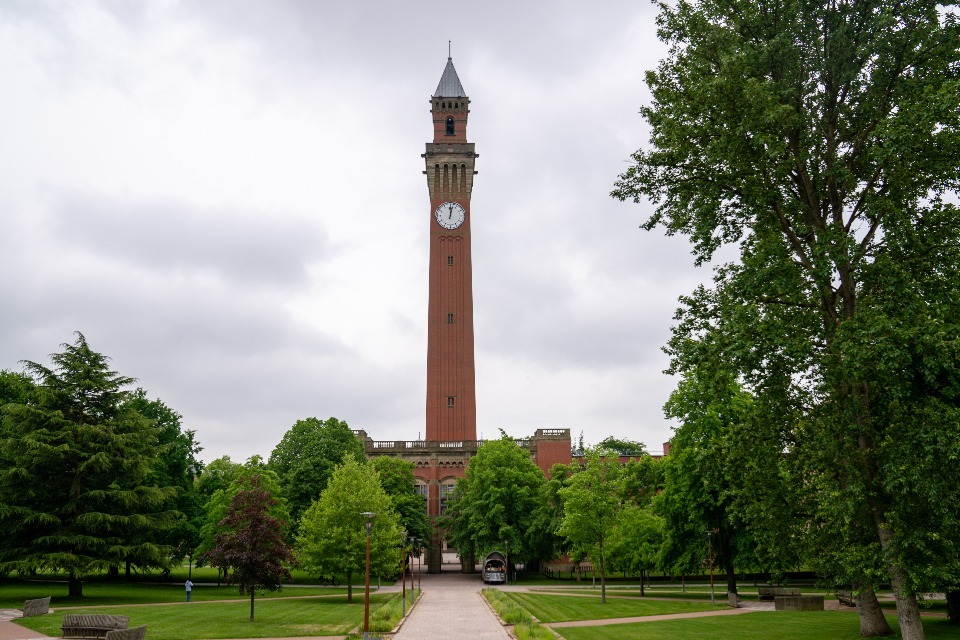
Urban trees at the University of Birmingham. Copyright: University of Birmingham.
The BUFMP (2021-2051) is the first of its kind in the UK and was led by the third sector organisation Birmingham TreePeople. It is a strategic plan that states the intentions for the trees, green space and natural capital of the city.
The plan defines the aspirations of the council, its urban forest managers, and key stakeholders. It takes a long-term approach with an action-based strategy and sets out measurable targets for strengthening the city’s urban forest over the next 30 years.
The Birmingham Tree Board, made up of representatives from the council, non-governmental organisations and business, oversees the delivery of the BUFMP, meaning the vision and targets for 2021-2051 are protected and are not subject to change in terms of election cycles.
The BUFMP has a strong focus on environmental justice and using trees and green infrastructure as a means of levelling up (tree equity).
City of Trees – green skills
City of Trees has established an in-house contracting team, building on their green skills programme.
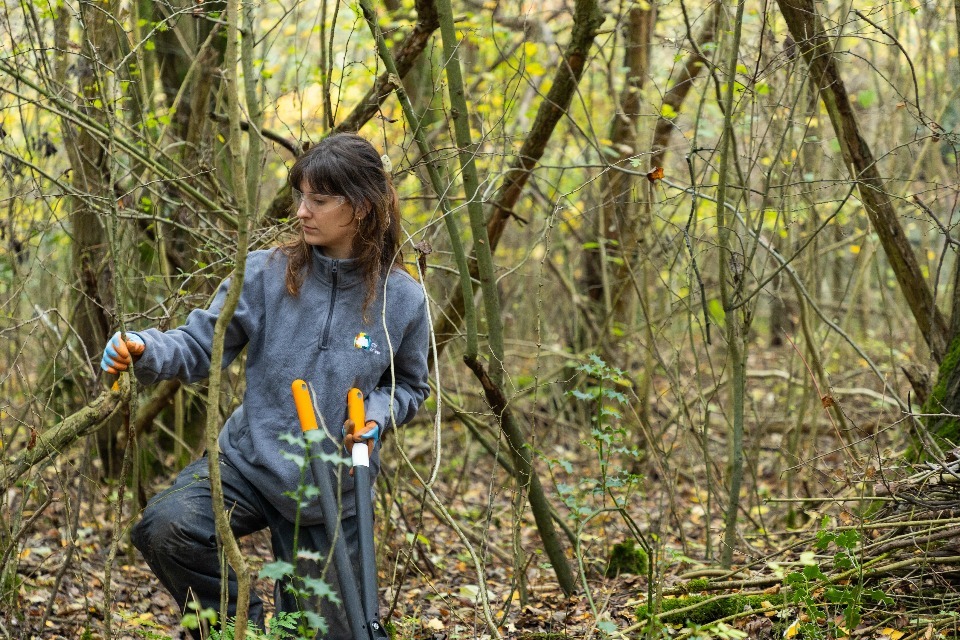
A green skills volunteer attending to trees. Copyright: City of Trees.
The team offers paid employment opportunities to individuals who would not necessarily pursue a career in the sector perhaps due to lack of experience.
City of Trees have been able to employ five new foresters directly and provide experience for many more passing through the team, working with the local community.
The long-term plan for the contracting team is to build capacity in-house for the maintenance of existing woodlands in the region for the benefit of local communities and biodiversity.
Goal 3: bigger benefits for nature, climate, people and the economy
Thriving for the Future recognises the immense benefits that trees and woodlands can deliver for nature, climate, people and the economy. We believe it is absolutely vital that those bigger benefits are realised particularly in the urban forest, which is where most of us live. We would like to see recognition of the benefits that urban trees and woodlands provide to people in terms of health and wellbeing, positive economic impacts, climate change mitigation and nature recovery.
We would like to see more urban tree managers working closely with local communities to manage the urban forest in a way that recognises the interests and needs of those communities and engages more diverse sections of society. Urban tree managers should recognise that local authorities do not directly manage large parts of the urban forest. These include trees in private gardens and woodlands owned by other organisations. They should work with a range of stakeholders, such as third sector organisations and community groups. This collaboration will help ensure that all parts of the urban forest are well managed to provide benefits for everyone.
We believe there is real benefit to young people in having meaningful contact with nature through experiencing the urban forest, through initiatives such as forest schools and volunteering with community groups. Fostering a life-long connection with nature will ensure that young people are able to tap into the multiple benefits that the urban forest can provide throughout the rest of their lives.
Main ambitions for the urban forest under goal 3
Recognition – the urban forest will be recognised as providing essential benefits for people near to where they live, for example access to nature and as a place where nature-based activities for health and wellbeing take place.
Benefits for people – more trees will be planted and managed near where people live and more of the urban forest will be managed with people in mind to unlock the government’s ambition to realise the multiple benefits trees and woodlands provide, for example climate change resilience, health and wellbeing and engagement with nature.
Benefits for nature – the urban forest will be managed with nature recovery in mind and species selection and management practices will reflect the importance of the urban forest for wildlife.
Community engagement – more urban tree managers will give due attention to the wishes and needs of local communities when planning how they manage the urban forest. This will include engaging with ‘under engaged with’ communities.
Young people – young people living in urban areas will have access to the urban forest near to where they live in order to help forge a connection with nature.
Case studies
Tree equity
‘Tree equity’ refers to equitable access to the benefits of trees. The term was first coined in America. However, it is now becoming part of the urban forestry in the UK, most likely in response to the Woodland Trust-led project to map tree equity with partners American Forests and the Centre for Sustainable Health Care. Tree equity as a tool is still being developed and will in future likely include more detail on factors such as type of species and condition of urban trees.
Local authorities can assess their tree equity themselves by mapping urban tree canopy cover and overlaying this with socio-economic data - Birmingham has completed this for example as part of their Urban Forest Master Plan.
Local authorities are now starting to include tree equity in their tree strategies, stating that tree planting efforts should be focussed in the areas of lower tree equity. In addition, ‘tree planting initiative’ funders can specify that funding will be given in preference to projects in area of low tree equity.
Communi Tree
Communi Tree is an initiative in the London Borough of Camden that partners with the Council and the KOKO Foundation to plant trees on council estates. They are committed to increasing the number of trees planted on estates by engaging the local community to plant the trees in the locations agreed by the council.
What makes this unique to other community planting initiatives is residents between 16-25 years old are paid to water the trees for the first 2 years. This provides young people from disadvantaged backgrounds with important work experience and exposure to a possible future career in the tree industry. Over the last 3 years Communi tree have planted 170 trees.
The Greater Manchester Nature for Health Programme (NfH)
NfH supports a network of over 500 practitioners who are involved in delivering nature-based activities and interventions for health and wellbeing across the city-region. City of Trees leads the network’s steering group.

A Nature for Health volunteer training event. Copyright: City of Trees.
NfH supports the training of the voluntary, community and social enterprise sector through co-production of training workshops and the creation of the NfH resource hub. Through the network and training, NfH has created a sustained action of nature for wellbeing activities, due to its identified results for wellbeing, socio-economic, and environmental outcomes.
During the test and learn programme in 2021-2023, 925 green social prescribing activities took place, engaging with 1,082 individuals. This phase demonstrated that nature for wellbeing activities can be effectively integrated and scaled at a local level.
The next phase of delivery (2024-2025) aims to produce the data and evidence needed to support national scale funding opportunities for green social prescribing activities.
Citizen Forester
The Citizen Forester programme engages individuals from all areas of Greater Manchester in the work and mission of City of Trees. City of Trees work closely with community groups across the voluntary, community and social enterprises sector to invite individuals to engage and connect to environmental work in a way that resonates with them, as well as engaging with communities local to City of Trees’ tree planting and woodland management activities.

Citizen Forester volunteers get to work. Copyright: City of Trees
By engaging with diverse communities, the Citizen Forester programme is strengthened by volunteers’ lived experiences of their local green spaces. Engaging the local community in the planting or maintenance of green spaces on their doorstep creates a sense of stewardship that sustains the care of establishing woodlands. It also provides a way for people to feel part of a movement, taking positive action for Greater Manchester in tackling the climate and biodiversity emergency.
Citizen Foresters engaged in environmental volunteering has a huge impact on City of Trees’ tree planting and management programme with 1,238 Citizen Foresters donating 4378 hours of their time in the 2023-2024 planting season.
As well as environmental outcomes, Citizen Forester provides wellbeing benefits for individuals. Out of 130 participants surveyed from 2021-2023, 89% of individuals showed an improved mood following Citizen Forester activities and 67% of individuals recorded an increased feeling of social connection.
